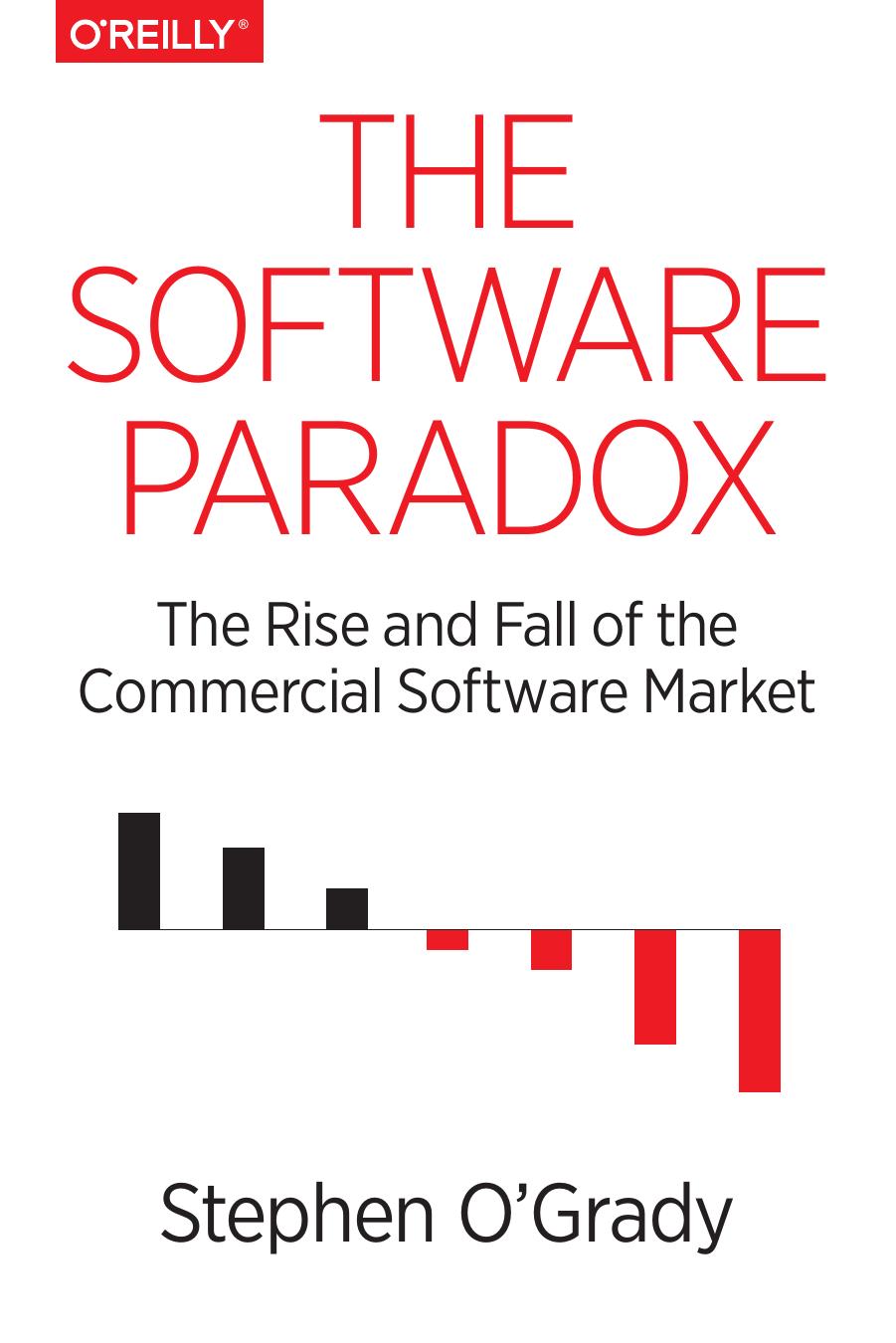The Software Paradox: The Rise and Fall of the Commercial Software Market by Stephen O'Grady

Author:Stephen O'Grady [O'Grady, Stephen]
Language: eng
Format: epub, azw3, pdf
Tags: Computers, COMPUTERS / History, History
ISBN: 9781491937693
Google: jR8hCgAAQBAJ
Publisher: O'Reilly Media, Inc.
Published: 2015-05-18T21:04:55+00:00
Atlassian
Founded in 2002 by Mike Cannon-Brookes and Scott Farquhar, Atlassian was a small Australian software company bootstrapped on $10,000 in credit card funding. By 2011, the private company announced its annual revenues had eclipsed $100 million. As of March 2014, the company had 35,000 organizations using its products and was valued by the private market at $3.3 billion.
This growth trajectory is impressive but hardly unprecedented by technology industry standards; at the same age, for example, Microsoft was worth over $20 billion, not adjusted for inflation. Atlassian has achieved this valuation, however, in spite of some potential strategic limitations.
Most famously, Atlassian doesn’t employ sales people. This likely isn’t technically true, as they report 15–20% of annual revenue is applied to sales and marketing resources. But there is no question that relative to its peers, Atlassian is substantially under-resourced with respect to salespeople. Instead, Atlassian has relied on clear, accessible pricing, bottom-up adoption, and developer-enabled word-of-mouth to progress from a two-person startup to an 800-strong, pre-IPO software vendor.
More interesting, however, was the nature of the product itself. When Atlassian was founded in 2002, selling strictly proprietary software was not unusual. Quite the contrary: Red Hat, one of the few commercial open source vendors at the time, had only been a publicly traded entity for three years. By 2014, however, it became more and more unusual for organizations not to make some portion of their portfolio open source for competitive, strategic, or simply practical reasons. Atlassian, however, has not chosen to leverage open source as part of their strategy, possibly because they haven’t had to. Sales growth has clearly not been an issue, and the company has generated goodwill in a variety of communities due to their decision to make their software available for free for open source projects.
Growth aside, however, it’s difficult to imagine the company achieving its $3+ billion valuation without the October 2011 addition of OnDemand. Prior to its introduction, the majority of the Atlassian product catalog was made available as software-only, rather than as a service. This meant that the burden of installation, configuration, and maintenance was principally on the user. With OnDemand, Atlassian made virtually its entire product catalog available as a remotely hosted and managed service.
It has become increasingly important for all companies to be capable of delivering their software as a service, to cater to customers that prefer to consume it in that fashion. But this was even more true of Atlassian. Given the base for its typical adoption cycle, in which one or more components are acquired by an individual or small team, minimizing the friction of adoption is enormously important. SaaS is an ideal way to accomplish this, because it shifts the operational burden from user to vendor.
What this means for Atlassian moving forward is that if the observed downward trajectory of available commercial software licensing revenue in the wider market continues, the company is inherently hedged with its OnDemand line. Longer term, as well, the company stands to gain by having operational visibility into a growing percentage of its user base’s implementations.
Download
The Software Paradox: The Rise and Fall of the Commercial Software Market by Stephen O'Grady.azw3
The Software Paradox: The Rise and Fall of the Commercial Software Market by Stephen O'Grady.pdf
This site does not store any files on its server. We only index and link to content provided by other sites. Please contact the content providers to delete copyright contents if any and email us, we'll remove relevant links or contents immediately.
Mastering Bitcoin: Programming the Open Blockchain by Andreas M. Antonopoulos(2890)
Dawn of the New Everything by Jaron Lanier(2686)
Blockchain: Ultimate Step By Step Guide To Understanding Blockchain Technology, Bitcoin Creation, and the future of Money (Novice to Expert) by Keizer Söze(2379)
Alibaba by Duncan Clark(1978)
Owning Bitcoin: The Illustrated Guide to Security, Privacy, and Potential by Apodaca Richard(1893)
Foundations of Blockchain by Koshik Raj(1893)
Significant Zero by Walt Williams(1885)
The Mastermind by Evan Ratliff(1826)
Mastering Blockchain by Imran Bashir(1782)
Bitcoin: The Basics of Blockchain and Investing in Cryptocurrency by K. Connors(1733)
Bitcoin: The Ultimate Guide to the World of Bitcoin, Bitcoin Mining, Bitcoin Investing, Blockchain Technology, Cryptocurrency (2nd Edition) by Ikuya Takashima(1613)
Attack of the 50 Foot Blockchain by David Gerard(1612)
The Bitcoin Standard: The Decentralized Alternative to Central Banking by Saifedean Ammous(1596)
Cryptocurrency by Neil Hoffman(1558)
Shaping the Fourth Industrial Revolution by Klaus Schwab & Nicholas Davis & Satya Nadella(1550)
Turing's Cathedral by George Dyson(1539)
Dawn of the New Everything: Encounters with Reality and Virtual Reality by Jaron Lanier(1539)
The Bitcoin Guidebook by Ian DeMartino(1523)
Bill Gates by Michael Becraft(1478)
